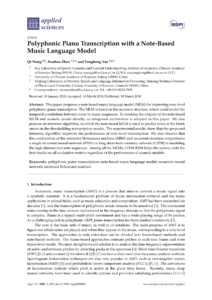Polyphonic Piano Note Transcription
Recent advances in polyphonic piano note transcription have involved the deliberate design of neural network architectures that detect different note states and model the temporal evolution of notes. However, most of these architectures use multipleloss functions and abstract connections to model note state transitions. We propose a unified neural network architecture that uses a single loss function to predict multiple note states. This architecture also uses auto-regressive connections to learn the temporal order of notes.
To train the system, we train a handcrafted Hidden Markov Model, which is compact in parameters and easy to train with gradient descent. Afterwards, we fuse the network outputs over time to obtain note segmentations. To achieve this, we select HMM transition probabilities that are based on the ADSR envelope model, a common sound synthesis model. Finally, we apply a binary decision rule to the note segments.
This model is trained on samples of real piano recordings and synthesized piano instruments. It has a high degree of generalization compared to other systems. It has been tested using recordings created on the Yamaha Disklavier piano. The results are promising. We hope to apply this method to other musical instruments.
While modeling the polyphonic AMT system has proven challenging, recent research results and data from musical scores provide a foundation for further research. Recently, researchers have demonstrated improvements in transcription performance with MLMs trained on MIDI ground truth. These models are trained on a sequence of binary note combinations, which most note events repeat many times in the ground truth representation. Then, they learn to predict the next frame of notes from the previous inputs. By repeating previous inputs, they improve their transcription performance.

Polyphonic Piano Note Transcription With Recurrent Neural Networks
The MAPS dataset consists of nine parts, each one containing 30 piano performances. The pieces are chosen randomly from a list of two hundred and sixty-eight classical pieces. Some are played by one piano, while others are played by several. This dataset is also divided into two sets: onsets and frames.
This dataset contains several problems that make automatic piano transcription difficult, including unbalanced pitch distribution, shifted harmonics, and missing notes of low velocity. In addition, it contains pieces with incorrect randomisation. In order to address these problems, Deep Learning is applied to acoustic models.
The algorithm uses a combination of LSTMs and Kelz architecture. In addition to using a threshold function, the model uses a thresholded version of the Onset detector. This enables the model to predict the frame only when the onset detector agrees with the frame prediction.
Convolutional layers use local information to improve prediction. They are less efficient than fully connected layers because they need more training steps to reach the same performance. The convolutional layer is less complex than the fully connected layer, and it can save only the most important local information. It also has more filters than a fully connected layer because it requires more general information.